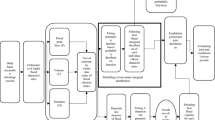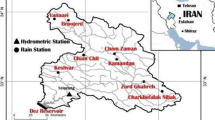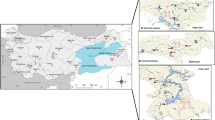Abstract
The flood characteristics, namely, peak, duration and volume provide important information for the design of hydraulic structures, water resources planning, reservoir management and flood hazard mapping. Flood is a complex phenomenon defined by strongly correlated characteristics such as peak, duration and volume. Therefore, it is necessary to study the simultaneous, multivariate, probabilistic behaviour of flood characteristics. Traditional multivariate parametric distributions have widely been applied for hydrological applications. However, this approach has some drawbacks such as the dependence structure between the variables, which depends on the marginal distributions or the flood variables that have the same type of marginal distributions. Copulas are applied to overcome the restriction of traditional bivariate frequency analysis by choosing the marginals from different families of the probability distribution for flood variables. The most important step in the modelling process using copula is the selection of copula function which is the best fit for the data sample. The choice of copula may significantly impact the bivariate quantiles. Indeed, this study indicates that there is a huge difference in the joint return period estimation using the families of extreme value copulas and no upper tail copulas (Frank, Clayton and Gaussian) if there exists asymptotic dependence in the flood characteristics. This study suggests that the copula function should be selected based on the dependence structure of the variables. From the results, it is observed that the result from tail dependence test is very useful in selecting the appropriate copula for modelling the joint dependence structure of flood variables. The extreme value copulas with upper tail dependence have proved that they are appropriate models for the dependence structure of the flood characteristics and Frank, Clayton and Gaussian copulas are the appropriate copula models in case of variables which are diagnosed as asymptotic independence.









Similar content being viewed by others
References
Adamson P T, Metcalfe A V and Parmentier B 1999 Bivariate extreme value distributions: An application of the Gibbs sampler to the analysis of floods; Water Resour. Res. 35 2825–2832.
Aghakouchak A, Ciach G and Habib E 2010 Estimation of tail dependence coefficient in rainfall accumulation fields; Adv. Water Resour. 33 1142–1149.
Aissia M a B, Chebana F, Ouarda T B M J, Roy L, Desrochers G, Chartier I and Robichaud É 2012 Multivariate analysis of flood characteristics in a climate change context of the watershed of the Baskatong reservoir, Province of Québec, Canada; Hydrol. Process. 26 130–142.
Bacro J-N, Bel L and Lantuéjoul C 2010 Testing the independence of maxima: From bivariate vectors to spatial extreme fields; Extremes 13 155–175.
Beguería S 2005 Uncertainties in partial duration series modelling of extremes related to the choice of the threshold value; J. Hydrol. 303 215–230.
Bel L, Bacro J and Lantuéjoul C 2008 Assessing extremal dependence of environmental spatial fields; Environmetrics 19 163–182.
Bezak N, Brilly M and Šraj M 2014 Comparison between the peaks-over-threshold method and the annual maximum method for flood frequency analysis; Hydrol. Sci. J. 59 959–977.
Bonnin G M, Martin D, Lin B, Parzybok T, Yekta M and Riley D 2006 Precipitation–frequency atlas of the United States; NOAA Atlas 2.
Bortot P, Coles S and Tawn J 2000 The multivariate Gaussian tail model: An application to oceanographic data; J. R. Stat. Soc. Ser. C Appl. Stat. 49 31–49.
Capéraà P, Fougères A-L and Genest C 1997 A nonparametric estimation procedure for bivariate extreme value copulas; Biometrika 84 567–577.
Chebana F and Ouarda T B M J 2011 Multivariate quantiles in hydrological frequency analysis; Environmetrics 22 63–78.
Cherubini U, Luciano E and Vecchiato W 2004 Copula methods in finance; John Wiley & Sons.
Chowdhary H, Escobar L A and Singh V P 2011 Identification of suitable copulas for bivariate frequency analysis of flood peak and flood volume data; Hydrol. Res. 42 193–216.
Coles S 2001 An introduction to statistical modeling of extreme values; Springer.
Coles S, Heffernan J and Tawn J 1999 Dependence measures for extreme value analyses; Extremes 2 339–365.
Dong Nguyen D, Jayakumar K V and Agilan V 2018 Impact of climate change on flood frequency of the Trian reservoir in Vietnam using RCMS; J. Hydrol. Eng. 23 05017032.
Dung N V, Merz B, Bárdossy A and Apel H 2015 Handling uncertainty in bivariate quantile estimation – An application to flood hazard analysis in the Mekong Delta; J. Hydrol. 527 704–717.
Dupuis D J 2007 Using copulas in hydrology: Benefits, cautions, and issues; J. Hydrol. Eng. 12 381–393.
Falk M and Michel R 2006 Testing for tail independence in extreme value models; Ann. Inst. Stat. Math. 58 261–290.
Favre A-C, El Adlouni S, Perreault L, Thiémonge N and Bobée B 2004 Multivariate hydrological frequency analysis using copulas; Water Resour. Res. 40, https://doi.org/10.1029/2003WR002456.
Frahm G, Junker M and Schmidt R 2005 Estimating the tail-dependence coefficient: Properties and pitfalls; Insur. Math. Econ. 37 80–100.
Frick M, Kaufmann E and Reiss R-D 2007 Testing the tail-dependence based on the radial component; Extremes 10 109–128.
Fu G and Butler D 2014 Copula-based frequency analysis of overflow and flooding in urban drainage systems; J. Hydrol. 510 49–58.
Gaál L, Szolgay J, Kohnová S, Hlavčová K, Parajka J, Viglione A, Merz R and Blöschl G 2015 Dependence between flood peaks and volumes: A case study on climate and hydrological controls; Hydrol. Sci. J. 60 968–984.
Genest C and Favre A-C 2007 Everything you always wanted to know about copula modeling but were afraid to ask; J. Hydrol. Eng. 12 347–368.
Genest C, Ghoudi K and Rivest L-P 1995 A semiparametric estimation procedure of dependence parameters in multivariate families of distributions; Biometrika 82 543–552.
Genest C, Kojadinovic I, Nešlehová J and Yan J 2011 A goodness-of-fit test for bivariate extreme-value copulas; Bernoulli 17 253–275.
Genest C, Rémillard B and Beaudoin D 2009 Goodness-of-fit tests for copulas: A review and a power study; Insur. Math. Econ. 44 199–213.
Government V 2016 The operation of this multipurpose dam system in the Saigon-Dongnai River basin; Vietnam; http://www.chinhphu.vn/portal/page/portal/chinhphu/hethongvanban?mode=detail&document_id=184010.
Gudendorf G and Segers J 2011 Nonparametric estimation of an extreme-value copula in arbitrary dimensions; J. Multivariate Anal. 102 37–47.
Hao Z and Singh V P 2016 Review of dependence modeling in hydrology and water resources; Prog. Phys. Geogr. 40 549–578.
Jeong D I, Sushama L, Khaliq M N and Roy R 2014 A copula-based multivariate analysis of Canadian RCM projected changes to flood characteristics for northeastern Canada; Clim. Dyn. 42 2045–2066.
Joe H, Smith R L and Weissman I 1992 Bivariate threshold methods for extremes; J. R. Stat. Soc. B-Stat. Methodol. 54 171–183.
Karmakar S and Simonovic S 2009 Bivariate flood frequency analysis. Part 2: A copula-based approach with mixed marginal distributions; J. Flood Risk Manag. 2 32–44.
Katz R W 2013 Statistical methods for nonstationary extremes; In: Extremes in a changing climate (eds) AghaKouchak A, Easterling D, Hsu K, Schubert S and Sorooshian S, Springer, Dordrecht, WSTL 65 15–37.
Kim G, Silvapulle M J and Silvapulle P 2007 Comparison of semiparametric and parametric methods for estimating copulas; Comput. Stat. Data Anal. 51 2836–2850.
Kioutsioukis I, Melas D and Zerefos C 2010 Statistical assessment of changes in climate extremes over Greece (1955–2002); Int. J. Climatol. 30 1723–1737.
Klein B, Pahlow M, Hundecha Y and Schumann A 2010 Probability analysis of hydrological loads for the design of flood control systems using copulas; J. Hydrol. Eng. 15 360–369.
Kojadinovic I and Yan J 2010 Comparison of three semiparametric methods for estimating dependence parameters in copula models; Insur. Math. Econ. 47 52–63.
Lang M, Ouarda T and Bobée B 1999 Towards operational guidelines for over-threshold modeling; J. Hydrol. 225 103–117.
Ledford A W and Tawn J A 1996 Statistics for near independence in multivariate extreme values; Biometrika 83 169–187.
Li L, Xu H, Chen X and Simonovic S P 2009 Streamflow forecast and reservoir operation performance assessment under climate change; Water Resour. Manag. 24 83–104.
Lima C H R, Lall U, Troy T J and Devineni N 2015 A climate informed model for nonstationary flood risk prediction: Application to Negro River at Manaus, Amazonia; J. Hydrol. 522 594–602.
Mirabbasi R, Fakheri-Fard A and Dinpashoh Y 2012 Bivariate drought frequency analysis using the copula method; Theor. Appl. Climatol. 108 191–206.
Poulin A, Huard D, Favre A-C and Pugin S 2007 Importance of tail dependence in bivariate frequency analysis; J. Hydrol. Eng. 12 394–403.
Reddy M J and Ganguli P 2012 Bivariate flood frequency analysis of upper Godavari River flows using Archimedean copulas; Water Resour. Manag. 26 3995–4018.
Renard B and Lang M 2007 Use of a Gaussian copula for multivariate extreme value analysis: Some case studies in hydrology; Adv. Water Resour. 30 897–912.
Requena A I, Chebana F and Mediero L 2016 A complete procedure for multivariate index-flood model application; J. Hydrol. 535 559–580.
Ribatet M, Ouarda T B M J, Sauquet E and Gresillon J M 2009 Modeling all exceedances above a threshold using an extremal dependence structure: Inferences on several flood characteristics; Water Resour. Res. 45 W0340.
Saf B 2009 Regional flood frequency analysis using L-moments for the West Mediterranean region of Turkey; Water Resour. Manag. 23 531–551.
Salas Jose D, Heo Jun H, Lee Dong J and Burlando P 2013 Quantifying the uncertainty of return period and risk in hydrologic design; J. Hydrol. Eng. 18 518–526.
Salvadori G, Durante F and De Michele C 2013 Multivariate return period calculation via survival functions; Water Resour. Res. 49 2308–2311.
Sarhadi A, Burn D H, Concepción Ausín M and Wiper M P 2016 Time varying nonstationary multivariate risk analysis using a dynamic Bayesian copula; Water Resour. Res. 52 2327–2349.
Scarrott C and Macdonald A 2012 A review of extreme value threshold estimation and uncertainty quantification; REVSTAT Stat. J. 10 33–60.
Schmidt R and Stadtmüller U 2006 Non-parametric estimation of tail dependence; Scand. J. Stat. 33 307–335.
Serinaldi F, Bárdossy A and Kilsby C G 2015 Upper tail dependence in rainfall extremes: Would we know it if we saw it?; Stochastic Environ. Res. Risk Assess. 29 1211–1233.
Shiau J T 2003 Return period of bivariate distributed extreme hydrological events; Stochastic Environ. Res. Risk Assess. 17 42–57.
Solari S and Losada M A 2012 A unified statistical model for hydrological variables including the selection of threshold for the peak over threshold method; Water Resour. Res. 48 W10541.
Sraj M, Bezak N and Brilly M 2015 Bivariate flood frequency analysis using the copula function: A case study of the Litija station on the Sava River; Hydrol. Process. 29 225–238.
Sun X, Lall U, Merz B and Dung N V 2015 Hierarchical Bayesian clustering for nonstationary flood frequency analysis: Application to trends of annual maximum flow in Germany; Water Resour. Res. 51 6586–6601.
Thompson P, Cai Y, Reeve D and Stander J 2009 Automated threshold selection methods for extreme wave analysis; Coastal. Eng. 56 1013–1021.
Viglione A and Blöschl G 2009 On the role of storm duration in the mapping of rainfall to flood return periods; Hydrol. Earth Syst. Sci. 13 205–216.
Villarini G, Serinaldi F and Krajewski W F 2008 Modeling radar-rainfall estimation uncertainties using parametric and non-parametric approaches; Adv. Water Resour. 31 1674–1686.
Villarini G, Smith J A, Serinaldi F, Bales J, Bates P D and Krajewski W F 2009 Flood frequency analysis for nonstationary annual peak records in an urban drainage basin; Adv. Water Resour. 32 1255–1266.
Vittal H, Singh J, Kumar P and Karmakar S 2015 A framework for multivariate data-based at-site flood frequency analysis: Essentiality of the conjugal application of parametric and nonparametric approaches; J. Hydrol. 525 658–675.
Weller G B, Cooley D S and Sain S R 2012 An investigation of the pineapple express phenomenon via bivariate extreme value theory; Environmetrics 23 420–439.
Yilmaz A G, Imteaz M A and Perera B J C 2017 Investigation of non-stationarity of extreme rainfalls and spatial variability of rainfall intensity–frequency–duration relationships: A case study of Victoria, Australia; Int. J. Climatol. 37 430–442.
Yue S 1999 Applying bivariate normal distribution to flood frequency analysis; Water Int. 24 248–254.
Yue S, Ouarda T and Bobee B 2001 A review of bivariate gamma distributions for hydrological application; J. Hydrol. 246 1–18.
Zhang L and Singh V P 2006 Bivariate flood frequency analysis using the copula method; J. Hydrol. Eng. 11 150–164.
Zhang L and Singh V P 2007 Bivariate rainfall frequency distributions using Archimedean copulas; J. Hydrol. 332 93–109.
Acknowledgements
The authors gratefully acknowledge the National Hydro-Meteorological Service, Vietnam for providing daily time series of observed river discharge data and thank Dr Agilan for his valuable discussions.
Author information
Authors and Affiliations
Corresponding author
Additional information
Corresponding editor: Subimal Ghosh
Rights and permissions
About this article
Cite this article
Nguyen, D.D., Jayakumar, K.V. Assessing the copula selection for bivariate frequency analysis based on the tail dependence test. J Earth Syst Sci 127, 92 (2018). https://doi.org/10.1007/s12040-018-0994-4
Received:
Revised:
Accepted:
Published:
DOI: https://doi.org/10.1007/s12040-018-0994-4




